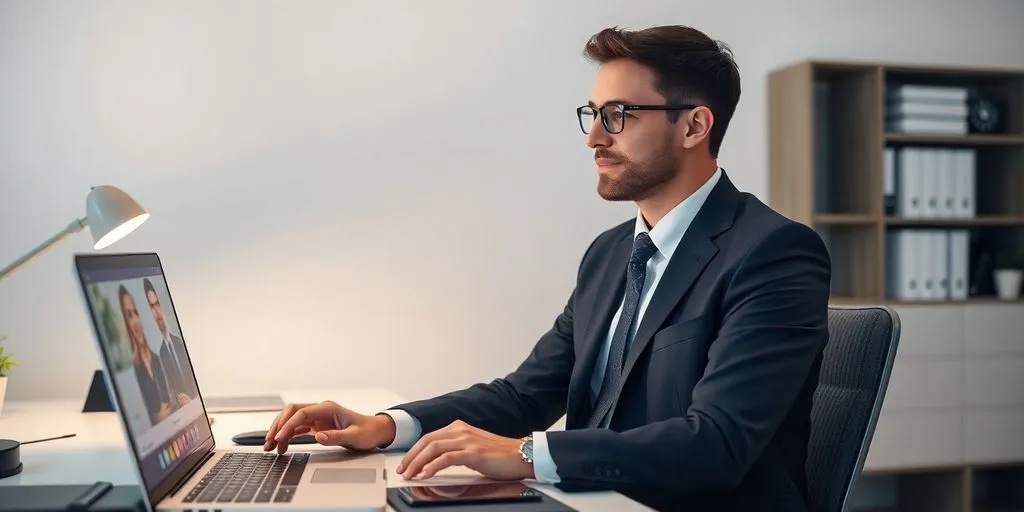Navigating Professionalism: Mastering Meeting Etiquette in Video Conferencing
October 2, 2024

In today's world, knowing how to behave in video meetings is really important. Whether you're just starting out or have been in the game for a while, understanding the rules of video conferencing can help you communicate better and work well with others. This guide will break down the key ideas of video meeting etiquette and give you useful tips to make your virtual meetings successful and professional.
Key Takeaways on Video Meeting Etiquette
- Importance of Etiquette: Video conferencing etiquette is essential for maintaining professionalism, enhancing communication, and fostering teamwork in virtual meetings.
- Setting Up Your Environment: Choose a quiet, organized location with good lighting and a tidy background to create a professional atmosphere for video calls.
- Dressing Professionally: Your appearance matters; wear appropriate business attire to show respect for your colleagues and boost your confidence.
- Effective Communication: Use clear, concise language, engage actively by maintaining eye contact, and utilize body language to convey attentiveness during meetings.
- Managing Time and Participation: Be punctual, encourage inclusive participation, and manage distractions to maintain a productive meeting environment.
- Utilizing Video Features: Familiarize yourself with video conferencing tools like screen sharing and chat functions to enhance communication and collaboration.
- Ending on a Positive Note: Summarize key takeaways, express gratitude to participants, and outline follow-up actions to reinforce a collaborative spirit.
- Handling Technical Issues: Prepare for potential technical challenges by testing equipment in advance and having a backup plan ready.
- Fostering Engagement: Encourage participation by inviting quieter members to share their thoughts and using non-verbal cues to show you are listening.
Register Your LLC
Company Registration
START NOWUnderstanding the Importance of Video Conferencing Etiquette
In today's world, where virtual meetings are common, video conferencing etiquette is crucial. It not only boosts your professionalism but also helps in better communication and teamwork. Here are some key points to consider:
Why Etiquette Matters in Virtual Meetings
- Respect for Time: Being on time shows you value others' schedules.
- Professional Image: Good etiquette reflects your seriousness about the meeting.
- Encourages Participation: A respectful environment makes everyone feel comfortable to share.
Impact on Professionalism and Collaboration
Proper video etiquette can lead to:
- Improved Communication: Clear guidelines help everyone understand each other better.
- Stronger Relationships: Respectful interactions build trust among team members.
- Enhanced Productivity: Meetings run smoother when everyone follows etiquette rules.
Common Etiquette Mistakes to Avoid
- Multitasking: This can signal disinterest and reduce your contributions.
- Interrupting Others: Wait for your turn to speak to show respect.
- Poor Technical Setup: Always test your equipment beforehand to avoid disruptions.
Mastering video conferencing etiquette is essential for successful virtual meetings. By following these guidelines, you can create a positive atmosphere that encourages effective teamwork and collaboration.
Setting Up Your Video Conferencing Environment
Creating a suitable environment for video conferencing is crucial for effective communication. A well-organized space can enhance your professionalism. Here are some key points to consider:
Choosing the Right Location
- Select a quiet area to minimize distractions.
- Ensure your background is tidy and professional.
- Close any irrelevant applications on your computer to avoid interruptions.
Optimizing Lighting and Background
- Position yourself in a well-lit area, preferably facing a window.
- Avoid backlighting, which can make you appear dark on screen.
- If needed, use a virtual background to maintain a professional appearance.
Ensuring Technical Preparedness
- Test your audio and video equipment before the meeting.
- Familiarize yourself with the video conferencing platform's features.
- Have a backup plan in case of technical issues, such as a phone for audio.
A distraction-free environment allows you to focus on the meeting and prevents interruptions.
By following these guidelines, you can create a professional atmosphere that fosters effective communication and collaboration during your video calls. Remember, your environment reflects your commitment to the meeting and respect for your colleagues.
Dressing Appropriately for Video Conferencing

Professional Attire Tips
When attending a video conference, your appearance matters. Here are some tips to help you dress appropriately:
- Choose business attire that fits the meeting's tone.
- Avoid busy patterns that can be distracting.
- Ensure your clothes are clean and wrinkle-free.
Avoiding Common Dress Code Mistakes
To maintain professionalism, steer clear of these common mistakes:
- Wearing casual clothing like pajamas or t-shirts.
- Choosing clothes with controversial messages or graphics.
- Over-accessorizing with noisy jewelry that can be distracting.
Impact of Appearance on Perception
Your appearance can greatly influence how others perceive you during video calls. Dressing well can boost your confidence and help you engage better. Remember, a polished look shows respect for your colleagues and the meeting itself.
Dressing appropriately for video conferences is not just about looking good; it’s about showing respect for the meeting and your fellow participants.
By following these guidelines, you can ensure that your appearance contributes positively to your virtual meetings.
Effective Communication During Video Conferences
Using Clear and Concise Language
Effective communication is key in video meetings. Speak clearly and use simple words to ensure everyone understands. Here are some tips:
- Avoid jargon or complicated terms.
- Keep your sentences short and to the point.
- Speak at a moderate pace to allow others to follow along.
Active Listening and Engagement
Listening is just as important as speaking. To show you are engaged:
- Maintain eye contact by looking at the camera.
- Nod or use facial expressions to show you are following the conversation.
- Take notes to remember important points.
Non-Verbal Cues and Body Language
Your body language can say a lot during video calls. Here’s how to use it effectively:
- Sit up straight to show you are attentive.
- Use hand gestures to emphasize points, but don’t overdo it.
- Avoid distractions in your background to keep the focus on you.
Remember, the more closely a video conference call replicates in-person conversation, the more effectively members can participate.
By following these guidelines, you can enhance communication and make your video meetings more productive.
Managing Time and Participation in Virtual Meetings
Being Punctual and Prepared
Arriving on time for a video meeting is just as important as it is for in-person gatherings. Being punctual shows respect for everyone’s time. Log in a few minutes early to ensure everything is set up correctly. This helps the meeting start smoothly and keeps it on track.
Encouraging Inclusive Participation
To make sure everyone feels included, actively engage with your colleagues. Here are some tips:
- Use non-verbal cues like nodding or raising your hand to show you’re listening.
- Allow others to share their thoughts without interruptions.
- Encourage quieter members to speak up by asking for their opinions.
Handling Distractions and Interruptions
Distractions can derail a meeting quickly. Here’s how to manage them:
- Find a quiet space to minimize background noise.
- Mute your microphone when you’re not speaking to reduce distractions.
- Stay focused on the discussion and avoid multi-tasking.
Maintaining meeting etiquette is essential for effective communication. Every virtual call is an opportunity to present yourself well and contribute positively to the team.
By following these guidelines, you can help create a productive and respectful virtual meeting environment.
Utilizing Video Conferencing Features

Screen Sharing and Presentation Tips
Using screen sharing can make your presentations clearer and more engaging. Here are some tips:
- Prepare your materials in advance to avoid fumbling during the call.
- Use clear visuals to help convey your message effectively.
- Practice navigating your presentation to ensure smooth transitions.
Using Chat and Reactions Effectively
The chat feature and reactions can enhance communication. Consider these points:
- Use the chat for quick questions or comments without interrupting the speaker.
- Utilize reactions like thumbs up or clapping to show engagement without speaking.
- Encourage participants to use chat for sharing resources or links during the meeting.
Recording and Follow-Up Procedures
Recording meetings can be beneficial for future reference. Here’s how to manage it:
- Inform participants that the meeting will be recorded.
- After the meeting, share the recording link with all attendees.
- Follow up with a summary of key points discussed and any action items.
Mastering video conferencing features is essential for effective communication. Utilizing these tools can significantly improve your meeting experience and foster better collaboration among team members. By being familiar with the features available, you can ensure a smoother and more productive virtual meeting.
Ending the Call on a Positive Note
Summarizing Key Takeaways
To wrap up your video call effectively, summarize the main points discussed. This helps everyone remember what was covered and what actions need to be taken. Here are some key points to include:
- Review the main topics discussed.
- Highlight any decisions made.
- List action items and who is responsible for them.
Expressing Gratitude and Appreciation
Always take a moment to thank everyone for their participation. A simple expression of gratitude can go a long way in building relationships. Consider saying:
- "Thank you all for your valuable input today!"
- "I appreciate everyone’s time and effort."
- "Your contributions made this meeting productive."
Planning Follow-Up Actions
Before ending the call, it’s important to discuss any follow-up actions. This ensures that everyone knows what to expect next. You might want to:
- Schedule the next meeting.
- Send a follow-up email summarizing the discussion.
- Assign tasks to specific individuals.
Ending the call on a positive note leaves a lasting impression of professionalism and encourages future collaboration. Remember, a strong call to action can motivate participants to stay engaged even after the meeting ends.
By following these steps, you can ensure that your video conferences conclude on a high note, fostering a sense of community and collaboration among participants.
Conclusion
In summary, understanding video conference etiquette is key to having successful online meetings. By following the right practices, you can improve your communication skills and make a great impression on others. Whether you are working from home or joining a virtual meeting, knowing how to behave properly in video calls is very important. By using these tips and showing good manners, you can help create a friendly and productive atmosphere. This will not only strengthen your professional relationships but also help you reach your goals in the world of online communication.
Frequently Asked Questions
What is video conferencing etiquette?
Video conferencing etiquette refers to the rules and best practices that help ensure professional and respectful behavior during online meetings.
Why is it important to dress professionally for video calls?
Dressing professionally shows respect for the meeting and the people attending. It helps create a serious atmosphere and boosts your confidence.
How can I prepare for a video conference?
You should test your technology, find a quiet space, dress appropriately, and review the meeting agenda beforehand.
What should I do if there are technical issues during the call?
Stay calm and try to resolve the issue quickly. If you can't fix it, let others know and consider joining again if possible.
How can I make sure everyone participates in the meeting?
Encourage participation by asking questions and inviting opinions from others. Make sure to give everyone a chance to speak.
What should I do at the end of the video call?
Summarize the main points discussed, thank everyone for their time, and outline any follow-up actions.

